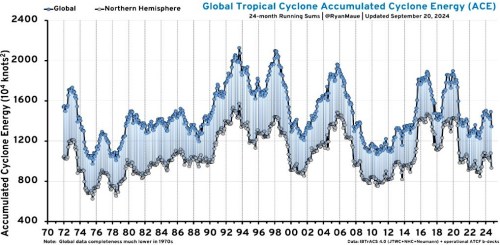Hurricane Helene made landfall on Friday, Sept 27 in Florida as a Category 4 storm and then made its way inland, dumping large amounts of rain followed by flooding.[emphasis, links added]
Predictably, many media outlets immediately rushed to blame climate change for this particular storm and its damage. These claims are false.
Data shows there is no climate signal over the past 50 years of hurricane activity either worsening intensity or creating more frequent hurricanes. Additionally, historical records show that flooding such as what was seen from this storm has happened in the same areas before.
This is the second time this week Climate Realism is covering this particular storm, but the claims from the media are extensive and worth debunking more than once.
Here’s a sampling of some of the headlines. The Hill wrote, “How climate change is intensifying storms like Hurricane Helene.”
Yahoo news claimed, “Helene shows that hurricanes in the age of climate change don’t wreck just coastlines,” while The Guardian opined, “ ‘Nowhere Is Safe’: Shattered Asheville Shows Stunning Reach Of Climate Crisis“.
The Associated Press (AP) chimed in with, “Helene and other storms dumped a whopping 40 trillion gallons of rain on the South.”
Even Jane Castor, the Mayor of Tampa, Fla., jumped on the climate alarm bandwagon by declaring in a CNN interview, “I don’t know that there’s anyone that anyone can deny the effects of climate change on the sheer power of the storms we’re seeing now.”
All of these claims ignore actual data and historical records. They also ignore the unique meteorological (not climatological) circumstances that created the potential for more rainfall and flooding.
First, it needs to be said that weather events are not climate events. Weather operates on vastly different timescales than climate does.
Second, the claims of climate change worsening storms such as Helene just don’t hold up when actual data is examined.
For example, meteorologist Ryan Maue, Ph.D, who is quoted in the AP story noted above maintains a running plot of “Accumulated Cyclone Energy”, which tracks how much power is actually in hurricanes on a month-by-month basis, seen in Figure 1 below, updated through 2024.

He writes on his research page:
Tropical cyclone accumulated cyclone energy (ACE) has exhibited strikingly large global interannual variability during the past 40 years. In the pentad since 2006, Northern Hemisphere and global tropical cyclone ACE has decreased dramatically to the lowest levels since the late 1970s. Additionally, the frequency of tropical cyclones has reached a historical low.
So much for the Mayor of Tampa’s claim that “I don’t know that there’s anyone that anyone can deny the effects of climate change on the sheer power of the storms we’re seeing now.” The actual data denies your claim.
If climate change were making such storms as Helene more powerful, it would show up in the ACE plot, but it doesn’t.
Further, meteorological science says there is no linkage between climate change and hurricanes.
A page on the topic maintained by the National Oceanic and Atmospheric Administration (NOAA) Geophysical Fluid Dynamics Laboratory clearly states there is no strong evidence for such claims:
Finally, climate science itself says there is no connection between climate change and hurricane strength or frequency.
In Table 12.12 on Page 90 – Chapter 12 of the UN Intergovernmental Panel on Climate Change (IPCC) Sixth Assessment Report.
The emergence of Climate Impact Drivers (CIDs) in time periods shows no indication of a connection in the present or the future.
The color in the table corresponds to the confidence of the region with the highest confidence: white colors indicate where evidence of a climate change signal is lacking or the signal is not present, leading to overall low confidence of an emerging signal. Note the colors for Tropical Cyclones in the table screencap below:
As mentioned in Climate at a Glance: Hurricanes, the IPCC’s AR6 WG1 report, released in August 2021, the IPCC noted, “Identifying past trends in TC [tropical storm] metrics remains a challenge,” a statement that essentially admits scientists have yet to identify a solid, measurable, upward trend in the data.
The media and uninformed politicians such as Tampa’s Mayor Castor seem to conveniently forget the recent past. The United States recently went more than a decade (2005 through 2017) without a major hurricane—a hurricane measuring Category 3 or higher—making landfall.
That is the longest such period in recorded United States history. If climate change was worsening hurricanes, such a drought of hurricanes wouldn’t have been possible.
Clearly, despite the hyped-up media claims, data, science, and history all show their claims of climate change affecting hurricanes to be completely untrue.
But what about the claims that Helene’s huge rainfall and subsequent flooding were caused by climate change? Meteorologist Chris Martz gave a complete analysis of the weather event on Twitter. Some excerpts:
I will take a moment to explain the meteorology behind the floods in North Carolina [and Tennessee]. The precipitation analysis for the last two days [from 12z today] reveals that over a foot of rain has fallen in the Appalachians. This amount of rain in such a short amount of time, regardless of land topography, results in widespread [and often devastating] inundation.
The reason you see 14-18 inches of rain [purple/pink contours in the image below] along the eastern slope of the Blue Ridge [mountains] is because of strong mountain-enhanced orographic lift. [in the second figure below] As moist parcels of air in the bands of Helene rotated counterclockwise through the region, they were then dynamically lifted to supersaturation on sloped terrain causing excess vapor to condense and precipitate out. On the leeward side in Tennessee, there was a bit of a rain shadow effect due to downslope flow, so rainfall totals were lower. This is what happens in the Hawaiian Islands on just about a daily basis.
So, a combination of the storm and local terrain made rainfall heavier in the mountains near Asheville, NC, like it always does. Climate had nothing to do with it.
And, history shows us this sort of heavy rain resulting in flooding around Asheville, North Carolina, has happened before. Here are some photos of a newspaper story and a photo of Asheville, NC from July 17, 1916, when a major flooding event occurred:

The challenge for the media and politicians is to explain how such a catastrophic flooding event occurred in Asheville before climate change ever became an issue, and the atmospheric content of carbon dioxide (said to increase climate change and storms supposedly driven by it) was far lower than today.
They can’t.
Instead, they would prefer to stick with a popular narrative claiming a “climate crisis” caused this storm and the subsequent damage rather than pay attention to data, science, and history which says the complete opposite.
This is wildly wrong, and beyond simple ignorance, it is journalistic and political malfeasance.
Read more at Climate Realism


























The M.S. Media have become just the typical leftists propagandists we can expect from them their all just about the same with the NYT’s in the lead
To a climate alarmist history is very inconvenient-something to be suppressed at all costs. Thus gives birth to the Ministry of Truth. George Orwell was a prophet.
Helene ran a track up the Florida Gulf Coast, where the water is shallower and warmer. The surge at landfall was funneled into the Big Bend area, worsening the damage. Watts identifies the factors in the southern Appalachians that amplify flooding. It is sad that all residents didn’t evacuate, head for the hills and survive. People are free to rebuild in the same hazard zone. Bad idea.